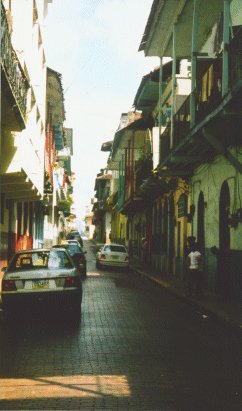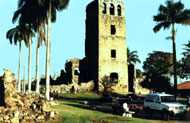Colonial History
 Panama City - Casco Viejo is the historic center of Panama City. It is a quiet, charming district of narrow streets overlooked by the flower bedecked balconies of two and three-story houses. At its tip lies French Park, a monument to the French builders who began the Panama Canal, and the lovely French Embassy. On the walkway around the monument. visitors have a fine view of the Amador Causeway and Bridge of the Americas, and of Panama City's skyscraper skyline to the east. A plaque on the walkway commemorates the firing of canon shots to drive away a Colombian warship and consolidate Panama's independence from Colombia in 1903. To one side of the monument is an old Spanish structure called Las Bovedas now used as an art gallery and French restaurant. Some excellent museums are found in the Casco Viejo, including the Canal Museum, which traces Panama's history as the route connecting Atlantic and Pacific from pre-Hispanic to modern times. Next door is the Museum of National History and the old cathedral, with gleaming spires inlaid with mother-of-pearl. Nearby is a small museum dedicated to religious art, found in the old Santo Domingo monastery, where visitors will also see the famous Flat Arch, which reportedly helped convince engineers that Panama was earth-quake-proof. At the San Jose Cathedral a few blocks away is the beautiful Gold Altar, intricately carved of wood and gilded with gold. Another beautiful building in the Casco Viejo is the Presidential House, which can be toured on Sundays. Panama City - Casco Viejo is the historic center of Panama City. It is a quiet, charming district of narrow streets overlooked by the flower bedecked balconies of two and three-story houses. At its tip lies French Park, a monument to the French builders who began the Panama Canal, and the lovely French Embassy. On the walkway around the monument. visitors have a fine view of the Amador Causeway and Bridge of the Americas, and of Panama City's skyscraper skyline to the east. A plaque on the walkway commemorates the firing of canon shots to drive away a Colombian warship and consolidate Panama's independence from Colombia in 1903. To one side of the monument is an old Spanish structure called Las Bovedas now used as an art gallery and French restaurant. Some excellent museums are found in the Casco Viejo, including the Canal Museum, which traces Panama's history as the route connecting Atlantic and Pacific from pre-Hispanic to modern times. Next door is the Museum of National History and the old cathedral, with gleaming spires inlaid with mother-of-pearl. Nearby is a small museum dedicated to religious art, found in the old Santo Domingo monastery, where visitors will also see the famous Flat Arch, which reportedly helped convince engineers that Panama was earth-quake-proof. At the San Jose Cathedral a few blocks away is the beautiful Gold Altar, intricately carved of wood and gilded with gold. Another beautiful building in the Casco Viejo is the Presidential House, which can be toured on Sundays.
Panama Viejo - Old Panama
 The anniversary of the opening of the Panama Canal to inter-oceanic traffic on August 15, 1914 is also the anniversary of the founding of Old Panama, on August 15, 1519. Panama was a fishing village on the coast of what was then called the South Sea. Six years after Balboa discovered the ocean, Pedrarias Davila, governor of Panama decided to locate his capital city on the site of the Indian village. On August 15, 1519, 395 years before the opening of the Panama Canal, Gaspar de Espinosa, chief alcalde of Darien, acting under the orders of Pedrarias, formally established the new city. On the day of the founding Pedrarias issued a proclamation promising to defend the capital for Dona Juana, the Queen, and Don Carlos, her son. It was two years after the founding of the city, however, that Don Carlos, by that time Charles V of Spain, created the city by royal decree and recognized it as the site of the Spanish government in the province of Panama. The city of Panama grew rapidly from the moment of its establishment, maintaining its position as chief post of the Pacific and terminus of the first transit route across the Isthmus. Through it passed all the great output of gold and silver from the rich mines of Peru and the mines in the province of Veraguas, as well as the products from the pearl fisheries in the Bay of Panama. The city survived several disastrous fires, but finally was destroyed by a band of pirates under Sir Henry Morgan in 1671. The anniversary of the opening of the Panama Canal to inter-oceanic traffic on August 15, 1914 is also the anniversary of the founding of Old Panama, on August 15, 1519. Panama was a fishing village on the coast of what was then called the South Sea. Six years after Balboa discovered the ocean, Pedrarias Davila, governor of Panama decided to locate his capital city on the site of the Indian village. On August 15, 1519, 395 years before the opening of the Panama Canal, Gaspar de Espinosa, chief alcalde of Darien, acting under the orders of Pedrarias, formally established the new city. On the day of the founding Pedrarias issued a proclamation promising to defend the capital for Dona Juana, the Queen, and Don Carlos, her son. It was two years after the founding of the city, however, that Don Carlos, by that time Charles V of Spain, created the city by royal decree and recognized it as the site of the Spanish government in the province of Panama. The city of Panama grew rapidly from the moment of its establishment, maintaining its position as chief post of the Pacific and terminus of the first transit route across the Isthmus. Through it passed all the great output of gold and silver from the rich mines of Peru and the mines in the province of Veraguas, as well as the products from the pearl fisheries in the Bay of Panama. The city survived several disastrous fires, but finally was destroyed by a band of pirates under Sir Henry Morgan in 1671.
|



